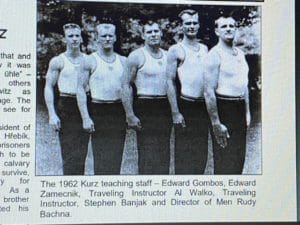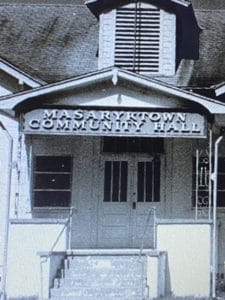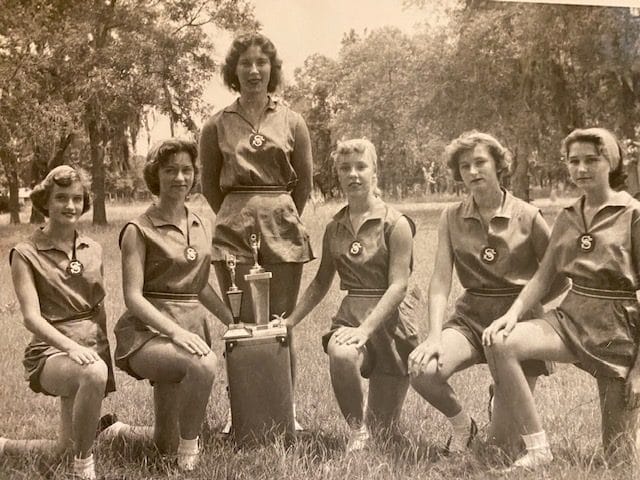The Summer Olympics have come and gone. I enjoyed watching them on TV. I thought of all those hours of practice and years of training, just for a few minutes in the Olympic spotlight. 2021 was a very strange year for athletes and it got me thinking about things like fitness, training, and yes, some more memories!
I grew up during a time when fitness was encouraged; Children played outside at any opportunity. We rode bicycles and played lots of games. I also liked to climb trees and be out in the woods. We only stopped for meals or total darkness. Anything to be outside! The Masaryktown Community Hall was a busy place in the ’50s and ’60s. We were often in its playground area or on the big concrete slab behind the building. The Community Hall hosted many social activities like dinners, parties, dances, weddings, and club meetings; Also gymnastics! Keeping fit seemed natural and a part of our Slovak heritage. As far back as the 1920’s Masaryktown had a Sokol organization.
What is a Sokol? The organization began over 150 years ago in Prague. It was founded in 1862 by Miroslav Tyrs and Jindrich Fugner; both men wanted to form a fitness club. Their ideas were borrowed from the Germans who had already applied gymnastics and group calisthenics toward military training. The men would name their new club Sokol, which translates to our word falcon; A strong and swift bird. It would be a fitting symbol for their active and vigorous lifestyle. Tyrs believed in having a sound mind in a strong body; This became a Sokol creed. Physical fitness and strength were not everything. It was important to have mental development. Emphasis was placed on education, social, and cultural activities. Men were referred to as brothers to promote equality. There was a Sokol greeting: Nazdar! Which means, “On to success.”
I was a young Sokolett by age five. Later I recalled many afternoons of gymnastics at the hall. By age eight or nine I was there at least once a week. We started each practice by forming a circle for the warm-up exercises; That sure got you limber from head to toe! Then on to group calisthenics. We would learn new routines and practice some of them each week. We’d also spend quite a bit of time on tumbling and floor exercises. There would be somersaults, headstands, handstands, and backbends. We even learned Slovak songs. Those would be sung at the end of practice during our cool-down time before dismissal.
In my teenage years I learned routines on various gymnastic equipment; balance-beams, the uneven bars, and vaulting horse. Today no one calls it a horse, it is a vaulting table. The boys had routines on uneven bars, parallel bars, and the vault and pommel horse. They also performed on the rings, which hung from straps and supports in the ceiling. I would always stop and watch that. The rings were for men and boys only. An athlete or spotter lifted you up just to reach them. Even a short routine on the rings required exceptional upper body strength.
We often had other instructors and gymnasts visit Masaryktown, they would teach, mentor, and perform. We all remembered one instructor, in particular, Rudy Bachna, from Ohio. He was a traveling ambassador for Sokol USA. He and his wife Janet visited in the ’50s and ’60s and stayed at the local Kovarcik Motel. A childhood accident kept Rudy from athletic competition yet he would amaze us with his strength and ability. We didn’t know at the time that we were watching a celebrity and observing someone who would make such an impact on the gymnastic world!

Rudy was born in Cleveland Ohio in 1928, the oldest son of Czech immigrants. After earning both an undergraduate and graduate degree, he taught physical education at Kent State. He was a faculty member there from 1963-1991. He coached both soccer and gymnastics and had a 32-year coaching career. He started Kent State gymnastics in 1959. His program would be the model followed by other universities around the United States. He trained two Olympic athletes. Both of them would win gold medals in the Pan Am Games. Rudy also judged four Olympic games, three Pan American Games, and two World Championships. In 1980 he was inducted into the Cleveland Sports Hall of Fame.
He was proud of his Slovak heritage. He began going to Sokols at age five. Then from 1935 to 1966 he participated in every Sokol exhibition, or slet. These events (slets) were held every four years in between the Olympics. Later at Kent State, he taught popular classes in the Czech language and dance. The students couldn’t get enough of his enthusiasm. Retirement in 1991 did not slow him down. Sadly, his wife Janet lost a battle with cancer in 1993. However, Rudy never lost his passion for athletics. He was a fixture at many Kent State home sporting events until his death on February 20, 2021, at the age of 92.
The gymnastic exhibitions at the Community Hall were a big deal and well attended. They were cultural events, gymnastics was just a part of it. The crowd also enjoyed the baked chicken or klobasa dinners, the special strudels and kolache, the Besada dancers, and the polka music. To perform we wore our white shirts with a Sokol emblem patch and a pair of dark shorts. Anxiously we waited in a side room for the opening music. That was our cue to march out in a single file line. We stood at attention for the Slovak and US national anthems and sang additional Slovak songs. The afternoon progressed with gymnastic routines followed by recognition of the top finishers. One year I received a gold charm which I put on a bracelet. That was my gold medal!
There was even a Sokol Retirement Motel and Vacation Club located on Courtney Campbell Causeway between Tampa and Clearwater. The motel had over 100 air-conditioned rooms, a private beach, and a luxurious swimming pool. A promotional postcard boasted of recreational activities like golf, fishing, and water skiing. It was a very popular place in the ’60s. One year the Sokol Motel hosted a gymnastic competition that included participants from Masaryktown, Tampa, and Miami. It was an all day event. Outside in the Florida heat. I can’t remember much about my performance but I remember getting very sunburned!
Gymnastics had been an organized sport in the US since the late 1800s. One event that brought focus to the Sokol movement was the slet of 1893. It was held in conjunction with the elaborate Chicago World’s Fair of that year. Imagine a time when electricity was brand new! Both Edison and Westinghouse would power the Fair with electricity. Chicago won out to be the host city. The Fair celebrated many new modern marvels. It also commemorated the 400th anniversary of the arrival of Christopher Columbus to the New World.
August 12, 1893, was declared Bohemian Day at the Exposition. Antonin Dvorak, a well-known Czech composer, had traveled to America and he gave a gala concert. He also wrote a new symphony to debut at the Fair. People of Slovak heritage came from all over the northeast. Over 20,000 marched through the streets in a parade that stretched for two to three miles. They carried flags, colorful banners, horses, carriages, marching bands and floats. Athletic men and women filled the streets as many as eight abreast. At the slet the crowds saw mass calisthenics. It was the first time this was done by a large number of athletes. That had to be an amazing sight! Hundreds performing the same routine together. They did it with precision despite a minimum rehearsal time together. How did they do it? That was easy. They had practiced it over and over back home at their Sokol clubs. It was automatic.
I also found it interesting that many slets had their own postcards and poster stamps. Some were very colorful works of art. They were used in advertising and became souvenirs. In 1965 the US Postal Service issued a special 5 cent stamp to commemorate the centennial of the Sokols. First Day of Issue envelopes also marked the 100th anniversary. Did you know that the Sokols have their own newsletter, too? It is a bi-monthly publication called Sokol Times that keeps members informed and updated. Their April 2021 publication carried several pages in tribute to the life and career of Rudy Bachna.
Carol Cimbora Gant, a former instructor of mine, attended a slet in Cleveland in 1958. There were over 2,000 participants from all over the United States and Canada. Carol’s group placed second in the Junior Girls Division and earned a nice trophy. Carol also received an individual third-place trophy. Masaryktown sent another group to Pittsburgh in June of 1962. John Hlavac, a former Sokol member, recalls attending there along with brother Paul.
I did not attend a slet but I can remember going to Sokol camp. All of us went at one time or another. A well-known camp was in Boonton, New Jersey, located 39 miles from New York City. Today it’s still a small town of fewer than 10,000 people. Carol Gant attended in 1957 along with Rudy and Janet Bachna. The Bachnas spent many summers as instructors at the three main Sokol camps in Pennsylvania, Wisconsin, and New Jersey. My brother Lou went to Boonton in 1963 and John Hlavac also attended in the early 1960s.
Sokol members Lydia Kovarcik Dodson and Peggy Buchtan went to New Kensington, Pennsylvania in the late 1960s. The camp was located 21 miles from Pittsburg. In addition to gymnastics, Lydia was able to reconnect with a childhood friend of ours, Jean Martinchek. Afterward, Lydia stayed and visited some relatives in New York and New Jersey. Imagine traveling to New York City as a teenager. Riding alone on a bus by yourself! It sure was a different time back then!

Lydia shared another interesting story. Her parents Paul and Christina met at Sokol camp in Boonton in 1949! They both worked as chefs. She recalled that her newlywed parents honeymooned in Florida. They liked Masaryktown so well that they bought the property in 1951. It wasn’t much to look at yet but it had a few motel cabins. Lydia can remember her Dad constructing more cabins brick by brick. This became the Kovarcik Motel, a fixture in the center of Masaryktown for many years. Many visiting Sokol gymnasts and instructors stayed there.
My friend Bobbie Buchtan and I went to camp at Sokol Woodlands in Barryville New York in 1968. I remember catching a glimpse of city lights (New York City) as we traveled back to the airport. We returned to Masaryktown as young instructors. After 50 years I still write letters to a gymnast from camp named Karen from Bethlehem, Pennsylvania. I look forward to her annual birthday cards and Christmas letters!
In sharing memories, Bobbie reminded me of another trip. We took a very long bus ride to Miami for a gymnastics meet; This was after Sokol camp. Our group competed against several other Florida cities and won “Best All Around.”
What about the Sokols today? Unfortunately, gymnastics in Masaryktown has ended. A 1974 fire at the Community Hall destroyed gymnastic equipment that had been stored away under the stage. Trophies were gone too, left as nothing but ashes! The hall would be rebuilt within a year, but the Sokol program for our small community never came back.
Many northern states still have very active Sokol organizations. They plan activities, hold fundraisers, and have gymnastics; They’ve adapted. They offer online learning and virtual training. There are posts to social media sites such as Facebook, Twitter, and Instagram. I’m sure there’ll be more changes to come. But one thing remains the same. Fitness is still encouraged, no matter the age. Sokols believe that you are never too old to learn and play.
In closing, I’ll just say…..
Nazdar! On to success!
My thanks to Carol Cimbora Gant, Lydia Kovarcik Dodson, Bobbie Buchtan, and John Hlavac for their contributions to this article.

